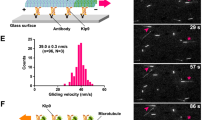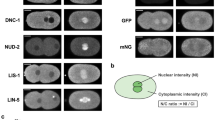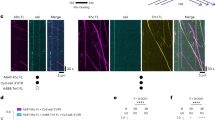Abstract
We describe the dynamics of kinetochore dynein–dynactin in living Drosophila embryos and examine the effect of mutant dynein on the metaphase checkpoint. A functional conjugate of dynamitin with green fluorescent protein accumulates rapidly at prometaphase kinetochores, and subsequently migrates off kinetochores towards the poles during late prometaphase and metaphase. This behaviour is seen for several metaphase checkpoint proteins, including Rough deal (Rod). In neuroblasts, hypomorphic dynein mutants accumulate in metaphase and block the normal redistribution of Rod from kinetochores to microtubules. By transporting checkpoint proteins away from correctly attached kinetochores, dynein might contribute to shutting off the metaphase checkpoint, allowing anaphase to ensue.
This is a preview of subscription content, access via your institution
Access options
Subscribe to this journal
Receive 12 print issues and online access
$209.00 per year
only $17.42 per issue
Buy this article
- Purchase on Springer Link
- Instant access to full article PDF
Prices may be subject to local taxes which are calculated during checkout








Similar content being viewed by others
References
Merdes, A., Heald, R., Samejima, K., Earnshaw, W. C. & Cleveland, D. W. Formation of spindle poles by Dynein/Dynactin-dependent transport of NuMA. J. Cell Biol. 149, 851–862 (2000).
Robinson, J. T., Wojcik, E. J., Sanders, M. A., McGrail, M. & Hays, T. S. Cytoplasmic dynein is required for the nuclear attachment and migration of centrosomes during mitosis in Drosophila.. J. Cell Biol. 146, 597–608 (1999).
Purohit, A., Tynan, S. H., Vallee, R. & Doxsey, S. J. Direct interaction of pericentrin with cytoplasmic dynein light intermediate chain contributes to mitotic spindle organization. J. Cell Biol. 147, 481–492 (1999).
Palazzo, R. E., Vaisberg, E. A., Weiss, D. G., Kuznetsov, S. A. & Steffen, W. Dynein is required for spindle assembly in cytoplasmic extracts of Spisula solidissima oocytes. J. Cell Sci. 112, 1291–1302 (1999).
Heald, R. et al. Self-organization of microtubules into bipolar spindles around artificial chromosomes in Xenopus egg extracts. Nature 382, 420–425 (1996).
Merdes, A., Ramyar, K., Vechio, J. D. & Cleveland, D. W. A complex of NuMA and cytoplasmic dynein is essential for mitotic spindle assembly. Cell 87, 447–458 (1996).
Vaisberg, E. A., Koonce, M. P. & McIntosh, J. R. Cytoplasmic dynein plays a role in mammalian mitotic spindle formation. J. Cell Biol. 123, 849–858 (1993).
O'Connell, C. B. & Wang, Y. L. Mammalian spindle orientation and position respond to changes in cell shape in a dynein-dependent fashion. Mol. Biol. Cell 11, 1765–1774 (2000).
Heil-Chapdelaine, R. A., Tran, N. K. & Cooper, J. A. Dynein-dependent movements of the mitotic spindle in Saccharomyces cerevisiae do not require filamentous actin. Mol. Biol. Cell 11, 863–872 (2000).
Adames, N. R. & Cooper, J. A. Microtubule interactions with the cell cortex causing nuclear movements in Saccharomyces cerevisiae. J. Cell Biol. 149, 863–874 (2000).
Gonczy, P., Pichler, S., Kirkham, M. & Hyman, A. A. Cytoplasmic dynein is required for distinct aspects of MTOC positioning, including centrosome separation, in the one cell stage Caenorhabditis elegans embryo. J. Cell Biol. 147, 135–150 (1999).
McGrail, M. & Hays, T. S. The microtubule motor cytoplasmic dynein is required for spindle orientation during germline cell divisions and oocyte differentiation in Drosophila. Development 124, 2409–2419 (1997).
Li, Y. Y., Yeh, E., Hays, T. & Bloom, K. Disruption of mitotic spindle orientation in a yeast dynein mutant. Proc. Natl Acad. Sci. USA 90, 10096–10100 (1993).
Carminati, J. L. & Stearns, T. Microtubules orient the mitotic spindle in yeast through dynein-dependent interactions with the cell cortex. J. Cell Biol. 138, 629–641 (1997).
Steuer, E. R., Wordeman, L., Schroer, T. A. & Sheetz, M. P. Localization of cytoplasmic dynein to mitotic spindles and kinetochores. Nature 345, 266–268 (1990).
Pfarr, C. M. et al. Cytoplasmic dynein is localized to kinetochores during mitosis. Nature 345, 263–265 (1990).
Sharp, D. J., Rogers, G. C. & Scholey, J. M. Cytoplasmic dynein is required for poleward chromosome movement during mitosis in Drosophila embryos. Nature Cell Biol. 2, 922–930 (2000).
Savoian, M. S., Goldberg, M. L. & Rieder, C. L. The rate of poleward chromosome motion is attenuated in Drosophila zw10 and rod mutants. Nature Cell Biol. 2, 948–952 (2000).
Starr, D. A., Williams, B. C., Hays, T. S. & Goldberg, M. L. ZW10 helps recruit dynactin and dynein to the kinetochore. J. Cell Biol. 142, 763–774 (1998).
Chan, G. K., Jablonski, S. A., Starr, D. A., Goldberg, M. L. & Yen, T. J. Human Zw10 and ROD are mitotic checkpoint proteins that bind to kinetochores. Nature Cell Biol. 2, 944–947 (2000).
Basto, R., Gomes, R. & Karess, R. E. Rough deal and Zw10 are required for the metaphase checkpoint in Drosophila. Nature Cell Biol. 2, 939–943 (2000).
King, J. M., Hays, T. S. & Nicklas, R. B. Dynein is a transient kinetochore component whose binding is regulated by microtubule attachment, not tension. J. Cell Biol. 151, 739–748 (2000).
Banks, J. D. & Heald, R. Chromosome movement: Dynein-out at the kinetochore. Curr. Biol. 11, R128–R131 (2001).
Shah, J. V. & Cleveland, D. W. Waiting for anaphase: Mad2 and the spindle assembly checkpoint. Cell 103, 997–1000 (2000).
Echeverri, C. J., Paschal, B. M., Vaughan, K. T. & Vallee, R. B. Molecular characterization of the 50-kD subunit of dynactin reveals function for the complex in chromosome alignment and spindle organization during mitosis. J. Cell Biol. 132, 617–633 (1996).
Karki, S. & Holzbaur, E. L. Cytoplasmic dynein and dynactin in cell division and intracellular transport. Curr. Opin. Cell Biol. 11, 45–53 (1999).
Scaërou, F. et al. The ZW10 and Rough Deal checkpoint proteins function together in a large, evolutionarily conserved complex targeted to the kinetochore. J. Cell Sci. (in the press).
Scaërou, F. et al. The rough deal protein is a new kinetochore component required for accurate chromosome segregation in Drosophila. J. Cell Sci. 112, 3757–3768 (1999).
Williams, B. C., Gatti, M. & Goldberg, M. L. Bipolar spindle attachments affect redistributions of ZW10, a Drosophila centromere/kinetochore component required for accurate chromosome segregation. J. Cell Biol. 134, 1127–1140 (1996).
Basu, J. et al. Mutations in the essential spindle checkpoint gene bub1 cause chromosome missegregation and fail to block apoptosis in Drosophila. J. Cell Biol. 146, 13–28 (1999).
Howell, B. J., Hoffman, D. B., Fang, G., Murray, A. W. & Salmon, E. D. Visualization of Mad2 dynamics at kinetochores, along spindle fibers, and at spindle poles in living cells. J. Cell Biol. 150, 1233–1250 (2000).
Gorbsky, G. J., Chen, R. H. & Murray, A. W. Microinjection of antibody to Mad2 protein into mammalian cells in mitosis induces premature anaphase. J. Cell Biol. 141, 1193–1205 (1998).
Gardner, R. D. & Burke, D. J. The spindle checkpoint: two transitions, two pathways. Trends Cell Biol. 10, 154–158 (2000).
Gepner, J. et al. Cytoplasmic dynein function is essential in Drosophila melanogaster. Genetics 142, 865–878 (1996).
Gonzalez, C. & Glover, D. M. in The Cell Cycle: A Practical Approach (eds Fantes, P. & Brooks, R.) 143–175 (IRL, Oxford, 1994).
Waterman-Storer, C. M. & Holzbaur, E. L. The product of the Drosophila gene, Glued, is the functional homologue of the p150Glued component of the vertebrate dynactin complex. J. Biol. Chem. 271, 1153–1159 (1996).
McGrail, M. et al. Regulation of cytoplasmic dynein function in vivo by the Drosophila Glued complex. J. Cell Biol. 131, 411–425 (1995).
Theurkauf, W. E. & Heck, M. M. Identification and characterization of mitotic mutations in Drosophila. Methods Cell Biol. 61, 317–346 (1999).
Acknowledgements
We acknowledge helpful discussions with all members of the Hays laboratory, and thank E. D. Salmon for communicating results before publication. This work was supported by grants to T.H. and E.W. from the National Institutes of Health (GM44757 and GM19123 respectively) and the American Heart Association (96002200). R.K., R.B. and F.S. performed this work at the UPR 2420 Centre de Génétique Moléculaire of the CNRS, associated with the Université Pierre et Marie Curie. R.K. was supported in part by grants from the CNRS and from the Association Pour la Recherche sur le Cancer (France). R.B. was supported by grants BD/11488/97 and P/BIA/111055/1998 from FCT, Portugal. F.S. was supported by Le Ministère Nationale de l'Enseignement Supérieur et de la Recherche.
Author information
Authors and Affiliations
Corresponding author
Rights and permissions
About this article
Cite this article
Wojcik, E., Basto, R., Serr, M. et al. Kinetochore dynein: its dynamics and role in the transport of the Rough deal checkpoint protein. Nat Cell Biol 3, 1001–1007 (2001). https://doi.org/10.1038/ncb1101-1001
Received:
Revised:
Accepted:
Published:
Issue Date:
DOI: https://doi.org/10.1038/ncb1101-1001
This article is cited by
-
CENP-E activation by Aurora A and B controls kinetochore fibrous corona disassembly
Nature Communications (2023)
-
Principles and dynamics of spindle assembly checkpoint signalling
Nature Reviews Molecular Cell Biology (2023)
-
Dynamics of kinetochore structure and its regulations during mitotic progression
Cellular and Molecular Life Sciences (2020)
-
Zw10 is a spindle assembly checkpoint protein that regulates meiotic maturation in mouse oocytes
Histochemistry and Cell Biology (2019)
-
Dynamic kinetochore size regulation promotes microtubule capture and chromosome biorientation in mitosis
Nature Cell Biology (2018)



